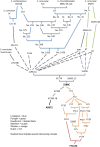The reference genome sequence of Saccharomyces cerevisiae: then and now
- PMID: 24374639
- PMCID: PMC3962479
- DOI: 10.1534/g3.113.008995
The reference genome sequence of Saccharomyces cerevisiae: then and now
Abstract
The genome of the budding yeast Saccharomyces cerevisiae was the first completely sequenced from a eukaryote. It was released in 1996 as the work of a worldwide effort of hundreds of researchers. In the time since, the yeast genome has been intensively studied by geneticists, molecular biologists, and computational scientists all over the world. Maintenance and annotation of the genome sequence have long been provided by the Saccharomyces Genome Database, one of the original model organism databases. To deepen our understanding of the eukaryotic genome, the S. cerevisiae strain S288C reference genome sequence was updated recently in its first major update since 1996. The new version, called "S288C 2010," was determined from a single yeast colony using modern sequencing technologies and serves as the anchor for further innovations in yeast genomic science.
Keywords: S288C; Saccharomyces cerevisiae; genome release; model organism; reference sequence.
Figures


References
-
- Amberg D. C., Burke D. J., Strathern J. N., 2005. Methods in yeast genetics: A Cold Spring Harbor Laboratory course manual. Cold Spring Harbor Laboratory Press, Cold Spring Harbor, NY
-
- Bowman S., Churcher C., Badcock K., Brown D., Chillingworth T., et al. , 1997. The nucleotide sequence of Saccharomyces cerevisiae chromosome XIII. Nature 387: 90–93 - PubMed
-
- Bussey H., Storms R. K., Ahmed A., Albermann K., Allen E., et al. , 1997. The nucleotide sequence of Saccharomyces cerevisiae chromosome XVI. Nature 387: 103–105 - PubMed
Publication types
MeSH terms
Associated data
- Actions
- Actions
- Actions
- Actions
- Actions
- Actions
- Actions
- Actions
- Actions
- Actions
- Actions
- Actions
- Actions
- Actions
- Actions
- Actions
- Actions
Grants and funding
LinkOut - more resources
Full Text Sources
Other Literature Sources
Molecular Biology Databases
